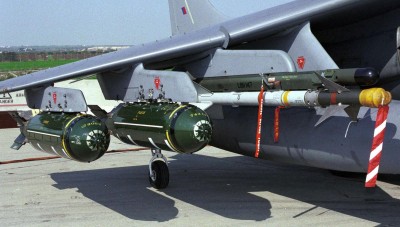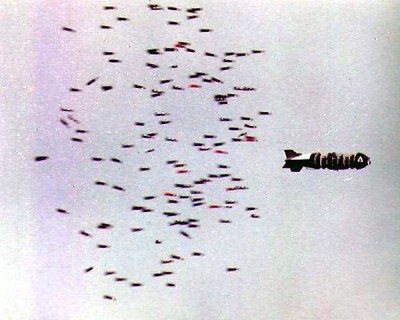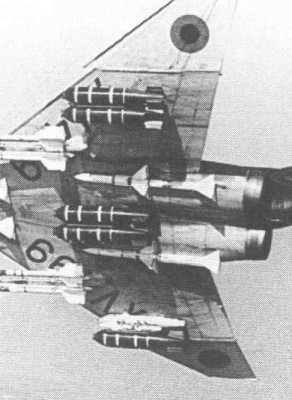BL-755
The development of this cluster bomb was carried out by Hunting Engeneering based on RAF requirements from the 1960s onwards. Features of the new weapon were to include a low drop height, a large amount of submunition carried and a large hit area. The first version, known as the BL-755 No.1 Mk.1, was fitted with 147 pieces of GP-type fragmentation submunition. This variant was first dropped from the aircraft in 1970, entering operational RAF service two years later.
In the 1970s, development of the weapon continued, resulting in the Mk.2, Mk.3 and Mk.4 versions. In the early 1980s, a new cumulative submunition against armoured targets, the AAA (Advanced Anti-Armor) type, was developed to cope with the armour on the upper parts of the new Soviet medium tanks. The armour penetration was to be up to 250 mm. It was tested in 1985, introduced into the RAF's armoury in 1986, and achieved operational capability in its ranks a year later. The bombs fitted with AAA submunitions are designated as BL-755 No.2 (according to some sources also IBL-755), the bomb also carries 147 of them as in the previous case.
The Cougar in all its versions is made up of three main structural parts. In the hemispherical nose is the SAFU (Safety Arming and Function Unit). The central cylindrical section with a two-piece casing carries its own submunition, stored radially in seven sections of 21 bombs each. In the centre is a charge for sweeping the submunition out of the container. The last part is the 0.9 m long tail section of No.119 with four extendable stabilising surfaces.
Due to the type of submunition, the GP bomb variant was most suited for attacking concentrations of enemy unarmored equipment or eliminating aircraft at enemy airfields. The minimum drop height was 35 metres, and the minimum speed at which the bomb could still be dropped was 500 km/h. The height of flight from which the bomb is dropped determines the resulting effect in the target area. Simply put, the size of the area hit decreases with increasing height, which in turn increases the destructive effect at the point of impact. The size of the hit area of an elliptical plan has extreme dimensions of about 90 by 30 meters (in the case of the GP submunition). However, the flight level from which the BL-755 could be dropped was not arbitrary - the bomb was designed only for drops from low altitudes.
The first and probably the most extensive combat deployment of BL-755 bombs was not in the ranks of the British Armed Forces, but with one of its export users, the Iranian Air Force, during the Iraq-Iran War. The Iranian Air Force purchased up to 3,000 of these bombs for its F-4E Phantom II aircraft in the 1970s. BL-755s were deployed from the very beginning of the war. On the second day of fighting on September 23, 1980, and the day after a surprise but largely unsuccessful Iraqi attack on Iranian airfields, there was a large-scale "response" in the form of a strike operation involving 140 Iranian Air Force aircraft. Some of these were bombed with BL-755 bombs. For example, eight F-4E jets serving at Tactical Fighter Base 1 targeted Iraq's Rashid Airport in Baghdad. Each of the aircraft carried six Mk.82, four BL-755s, two AIM-7 Sparrow and three auxiliary tanks. The following day, they were used again when a quartet of Phantoms 32nd Tactical Fighter Squadron attacked Iraq's extensive fuel depots in Arbil. The lead aircraft carried four BL-755s, while the rest of the formation was supported by six Mk.82. The BL-755 bombers also came into action on 4 April 1981 during a mission in which the Iranian Air Force bombed Al-Wallid Air Base. BL-755s were used in attacks against Iraqi airfields virtually throughout the war. Attacks against Iraqi ground forces became another area of deployment. In early 1985, Phantoms from Tactical Fighter Bases 3 and 4 repeatedly bombed Iraqi ground forces with BL-755 bombs, inflicting extensive losses. So much for the first deployment to the Middle East.
The British deployed their BL-755s in 1982 during the Falklands War. They were used, for example, on 1 May following the Black Buck 1 mission, when 9 Sea Harriers FRS.1 from 800 Squadron operating from the aircraft carrier HMS Hermes bombed the airfield at Port Stanley and the field airstrip at Goose Green with Mk.83 bombs and BL-755s. This resulted in one Argentine IA-58 Pucará destroyed at Goose Green and minor damage to Port Stanley airfield.
Another conflict in which BL-755s were used was the Persian Gulf War in 1991. Here, Jaguars from the RAF armament acted as the main carrier for these weapons. However, these dropped only 8 BL-755 bombs on enemy troops. The reason for this was that these bombs could only be bombed from low altitudes, whereas British Air Force tactics required attacks from medium altitudes (due to the lower risk of being hit by small arms, smaller calibre anti-aircraft artillery and portable anti-aircraft missile systems). It was therefore necessary to find an alternative weapon quickly - this became the American CBU-87 container bombs, which began to be used by the British Jaguars from 29 January (the war began on 17 January).
The introduction of American CBU-87 bombs into the RAF's armament proved untenable, and so, based on the experience of the "Gulf", a request was issued in 1992 for a modification of the bombs to allow them to be dropped from medium altitudes. In 1996, Hunting Engeneering developed a version of the RBL-755 with a radar non-contact fuse that allowed deployment from medium altitudes (above 10,000 ft / 3,305 m). Already produced BL-755s were modified to this standard in the second half of the 1990s.
The RBL-755s were used in 1999 during the Kosovo crisis as part of Operation Allied Force. The Harrier GR.7 from the 1st Squadron based at Gioia del Colle, Italy, became the main carriers during the fighting. During the operation, a total of 531 RBL-755 bombs were dropped (the older BL-755s were not used), their targets were airfields, concentrations of Serbian equipment (tanks, artillery,...) and also "soft" targets (truck assembly areas, enemy live forces,...). The RAF first deployed them on 6 April against a convoy of military equipment and tanks. The following day, 10 Harriers went to the battle area and attacked Serbian tanks and a convoy of 15 to 20 vehicles with RBL-755 bombs. One pair, armed with cluster bombs, bombed an equipment assembly area in southern Kosovo. Another pair then visited Serbian military vehicles parked on a road in western Kosovo with RBL-755. On 14 April, a submunition from RBL-755 went to a fuel depot near Pristina and a Serbian communications post and radar station. On April 17 and 18, Harriers container bombs attacked a facility believed to be the headquarters of Serbian special forces operating in Kosovo and armored and unarmored military vehicles. One of the largest deployments of RBL-755 apparently occurred on 5 May, when 32 of these bombs were dropped against Serbian vehicles and artillery emplacements. RBL-755s were used virtually throughout the conflict. However, more out of necessity. The Air Force was so dissatisfied with their performance that it issued an Urgent Operational Requirement to arm Harrier GR.7 with American AGM-65G2 Maverick anti-ship cruise missiles. The manufacturer estimates that about 5% of the dropped submunitions from RBL-755 bombs failed to explode.
Apparently the last combat deployment of RBL-755 bombs in the RAF ranks occurred in 2003 during the Iraq War. The British deployed these bombs during Operation Telic, the primary carriers of the RBL-755 were again Harrier GR.7.
By 2001, a total of approximately 52,500 BL-755 series bombs were to be produced, which entered the air forces of 17 nations (including Iran, Oman, Saudi Arabia, United Arab Emirates, Pakistan, India, Belgium, Germany, Netherlands, Italy, Switzerland, Yugoslavia).
The BL-755 series bombs are to be phased out of the British Air Force by 2008 and then scrapped. Their successor in the anti-tank role is to be the Brimstone.
Technical and tactical data
Weight:
- Total (including submunitions): 278 kg
- empty bombs: 127 kg
Dimensions:
- Length: 2 440 mm
- body diameter: 431 mm
Sources
1) Lennox, D. (editor): Janes Air-Launched Weapons, Coulsdon, 2002
2) Šimek, K.: Air-Launched Box Bombs, Aerospace and Airborne Forces, ?/1983
3) www.eurofighter-typhoon.co.uk
4) www.bw-flyer.de
5) www.bharat-rakshak.com
6) www.armedforces.co.uk
7) http://en.wikipedia.org/wiki/BL755
8) http://www.raf.mod.uk/equipment/clusterbombs.cfm
9) www.hrw.org
10) www.ukwatch.net
11) en.handicapinternational.be
The BL-755 was also used by the Belgian Air Force. The picture shows a bomb suspended under the wing of the F-16A at the military museum in Brussels (©Radek Havelka)
The development of this cluster bomb was carried out by Hunting Engeneering based on RAF requirements from the 1960s onwards. Features of the new weapon were to include a low drop height, a large amount of submunition carried and a large hit area. The first version, known as the BL-755 No.1 Mk.1, was fitted with 147 pieces of GP-type fragmentation submunition. This variant was first dropped from the aircraft in 1970, entering operational RAF service two years later.
In the 1970s, development of the weapon continued, resulting in the Mk.2, Mk.3 and Mk.4 versions. In the early 1980s, a new cumulative submunition against armoured targets, the AAA (Advanced Anti-Armor) type, was developed to cope with the armour on the upper parts of the new Soviet medium tanks. The armour penetration was to be up to 250 mm. It was tested in 1985, introduced into the RAF's armoury in 1986, and achieved operational capability in its ranks a year later. The bombs fitted with AAA submunitions are designated as BL-755 No.2 (according to some sources also IBL-755), the bomb also carries 147 of them as in the previous case.
The Cougar in all its versions is made up of three main structural parts. In the hemispherical nose is the SAFU (Safety Arming and Function Unit). The central cylindrical section with a two-piece casing carries its own submunition, stored radially in seven sections of 21 bombs each. In the centre is a charge for sweeping the submunition out of the container. The last part is the 0.9 m long tail section of No.119 with four extendable stabilising surfaces.
Due to the type of submunition, the GP bomb variant was most suited for attacking concentrations of enemy unarmored equipment or eliminating aircraft at enemy airfields. The minimum drop height was 35 metres, and the minimum speed at which the bomb could still be dropped was 500 km/h. The height of flight from which the bomb is dropped determines the resulting effect in the target area. Simply put, the size of the area hit decreases with increasing height, which in turn increases the destructive effect at the point of impact. The size of the hit area of an elliptical plan has extreme dimensions of about 90 by 30 meters (in the case of the GP submunition). However, the flight level from which the BL-755 could be dropped was not arbitrary - the bomb was designed only for drops from low altitudes.
The first and probably the most extensive combat deployment of BL-755 bombs was not in the ranks of the British Armed Forces, but with one of its export users, the Iranian Air Force, during the Iraq-Iran War. The Iranian Air Force purchased up to 3,000 of these bombs for its F-4E Phantom II aircraft in the 1970s. BL-755s were deployed from the very beginning of the war. On the second day of fighting on September 23, 1980, and the day after a surprise but largely unsuccessful Iraqi attack on Iranian airfields, there was a large-scale "response" in the form of a strike operation involving 140 Iranian Air Force aircraft. Some of these were bombed with BL-755 bombs. For example, eight F-4E jets serving at Tactical Fighter Base 1 targeted Iraq's Rashid Airport in Baghdad. Each of the aircraft carried six Mk.82, four BL-755s, two AIM-7 Sparrow and three auxiliary tanks. The following day, they were used again when a quartet of Phantoms 32nd Tactical Fighter Squadron attacked Iraq's extensive fuel depots in Arbil. The lead aircraft carried four BL-755s, while the rest of the formation was supported by six Mk.82. The BL-755 bombers also came into action on 4 April 1981 during a mission in which the Iranian Air Force bombed Al-Wallid Air Base. BL-755s were used in attacks against Iraqi airfields virtually throughout the war. Attacks against Iraqi ground forces became another area of deployment. In early 1985, Phantoms from Tactical Fighter Bases 3 and 4 repeatedly bombed Iraqi ground forces with BL-755 bombs, inflicting extensive losses. So much for the first deployment to the Middle East.
The British deployed their BL-755s in 1982 during the Falklands War. They were used, for example, on 1 May following the Black Buck 1 mission, when 9 Sea Harriers FRS.1 from 800 Squadron operating from the aircraft carrier HMS Hermes bombed the airfield at Port Stanley and the field airstrip at Goose Green with Mk.83 bombs and BL-755s. This resulted in one Argentine IA-58 Pucará destroyed at Goose Green and minor damage to Port Stanley airfield.
Another conflict in which BL-755s were used was the Persian Gulf War in 1991. Here, Jaguars from the RAF armament acted as the main carrier for these weapons. However, these dropped only 8 BL-755 bombs on enemy troops. The reason for this was that these bombs could only be bombed from low altitudes, whereas British Air Force tactics required attacks from medium altitudes (due to the lower risk of being hit by small arms, smaller calibre anti-aircraft artillery and portable anti-aircraft missile systems). It was therefore necessary to find an alternative weapon quickly - this became the American CBU-87 container bombs, which began to be used by the British Jaguars from 29 January (the war began on 17 January).
The introduction of American CBU-87 bombs into the RAF's armament proved untenable, and so, based on the experience of the "Gulf", a request was issued in 1992 for a modification of the bombs to allow them to be dropped from medium altitudes. In 1996, Hunting Engeneering developed a version of the RBL-755 with a radar non-contact fuse that allowed deployment from medium altitudes (above 10,000 ft / 3,305 m). Already produced BL-755s were modified to this standard in the second half of the 1990s.
The RBL-755s were used in 1999 during the Kosovo crisis as part of Operation Allied Force. The Harrier GR.7 from the 1st Squadron based at Gioia del Colle, Italy, became the main carriers during the fighting. During the operation, a total of 531 RBL-755 bombs were dropped (the older BL-755s were not used), their targets were airfields, concentrations of Serbian equipment (tanks, artillery,...) and also "soft" targets (truck assembly areas, enemy live forces,...). The RAF first deployed them on 6 April against a convoy of military equipment and tanks. The following day, 10 Harriers went to the battle area and attacked Serbian tanks and a convoy of 15 to 20 vehicles with RBL-755 bombs. One pair, armed with cluster bombs, bombed an equipment assembly area in southern Kosovo. Another pair then visited Serbian military vehicles parked on a road in western Kosovo with RBL-755. On 14 April, a submunition from RBL-755 went to a fuel depot near Pristina and a Serbian communications post and radar station. On April 17 and 18, Harriers container bombs attacked a facility believed to be the headquarters of Serbian special forces operating in Kosovo and armored and unarmored military vehicles. One of the largest deployments of RBL-755 apparently occurred on 5 May, when 32 of these bombs were dropped against Serbian vehicles and artillery emplacements. RBL-755s were used virtually throughout the conflict. However, more out of necessity. The Air Force was so dissatisfied with their performance that it issued an Urgent Operational Requirement to arm Harrier GR.7 with American AGM-65G2 Maverick anti-ship cruise missiles. The manufacturer estimates that about 5% of the dropped submunitions from RBL-755 bombs failed to explode.
Apparently the last combat deployment of RBL-755 bombs in the RAF ranks occurred in 2003 during the Iraq War. The British deployed these bombs during Operation Telic, the primary carriers of the RBL-755 were again Harrier GR.7.
By 2001, a total of approximately 52,500 BL-755 series bombs were to be produced, which entered the air forces of 17 nations (including Iran, Oman, Saudi Arabia, United Arab Emirates, Pakistan, India, Belgium, Germany, Netherlands, Italy, Switzerland, Yugoslavia).
The BL-755 series bombs are to be phased out of the British Air Force by 2008 and then scrapped. Their successor in the anti-tank role is to be the Brimstone.
Technical and tactical data
Weight:
- Total (including submunitions): 278 kg
- empty bombs: 127 kg
Dimensions:
- Length: 2 440 mm
- body diameter: 431 mm
Sources
1) Lennox, D. (editor): Janes Air-Launched Weapons, Coulsdon, 2002
2) Šimek, K.: Air-Launched Box Bombs, Aerospace and Airborne Forces, ?/1983
3) www.eurofighter-typhoon.co.uk
4) www.bw-flyer.de
5) www.bharat-rakshak.com
6) www.armedforces.co.uk
7) http://en.wikipedia.org/wiki/BL755
8) http://www.raf.mod.uk/equipment/clusterbombs.cfm
9) www.hrw.org
10) www.ukwatch.net
11) en.handicapinternational.be
The BL-755 was also used by the Belgian Air Force. The picture shows a bomb suspended under the wing of the F-16A at the military museum in Brussels (©Radek Havelka)


